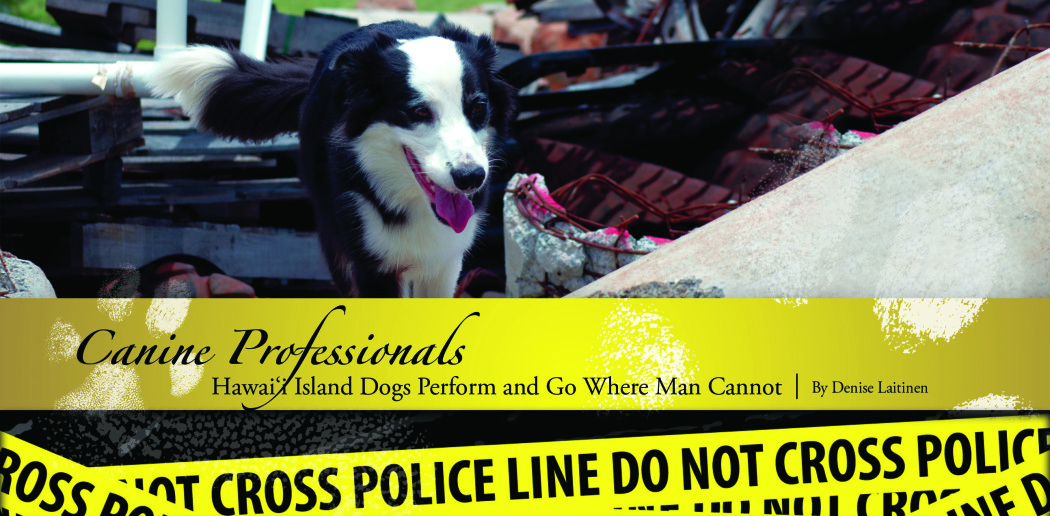
Canine Professionals: Hawai‘I Island Dogs Perform and Go Where Man Cannot
 By Denise Laitinen
By Denise Laitinen
They may look like any other dogs, but Kaimi can tell if a fire was intentionally set. Nalu can tell if you have drugs in your car. If you’re lost, Magnum will find you, and if you’re trapped in rubble from a disaster, Nui will search for you.
They are the unsung heroes of the Hawai‘i County Fire Department, Police Department, and Hawai‘i State Civil Defense Urban Search and Rescue Canine Unit. These hard-working dogs epitomize the phrase “man’s best friend”—happily taking on the roles of tracking missing persons, detecting arson fires, and sniffing out narcotics. Each agency varies in how they acquire the dogs and how the canines are trained, but the dogs’ individual specializations do not vary. For instance, a cadaver dog isn’t used in arson cases and a narcotics dog isn’t used to search for a missing person.
Four-year-old Kaimi, Hawai‘i County Fire Department’s sole arson canine, is trained to seek out accelerants used in residential, vehicle and wildland fires. Hawai‘i County is the only fire department in the state to have such a dog. Since May 2008 the former shelter dog and his handler, Captain Robert Perreira, have responded to 72 fires, including four on other islands. While not every fire they respond to is arson, “if the accelerant is there he’ll find it,” says Perreira. “His sense of smell is awesome.”
Unlike the police department’s canines, which were born and bred to be working dogs, Kaimi was rescued after having been abandoned at a shelter as a puppy. A shelter worker took notice of him and notified the local fire investigator, who in turn saw the dog’s training potential and alerted a national arson dog training program in Maine. Kaimi went through months of training at a facility in Illinois before joining the program in Maine.
Around the same time, Hawai‘i Fire Department received a grant from State Farm Insurance to acquire an arson dog, and Kaimi came to work in Hawai‘i. “All the costs were covered by State Farm Insurance,” says Perreira. “In addition to Kaimi’s training, they covered all my training and travel expenses to the mainland.”
Because the work of arson dogs and their handlers is crucial in trials and other legal documentation, both must annually go through recertification.
Kaimi lives and works with Perreira 24 hours a day. “He knows when I’m getting ready for work. He gets all excited. When we get to a fire scene, he can smell it and gets excited. He wants to find what he’s looking for.”
“They [arson dogs] are trained to find the source,” explains Perreira. When he and Kaimi arrive at a fire they walk the scene and identify any areas where Kaimi detects something.
After samples are collected, Kaimi sniffs the samples again to make sure they contain accelerants. The arson specialist is performance fed, meaning he’s given food throughout the day for tasks accomplished, instead of regular meals. Depending on how many tasks they do, Kaimi might eat 80 times a day, but only small amounts each time.
When not at a fire, Perreira does about 60-80 drills a day with Kaimi, varying the amount and types of drills daily. For instance, he might go to a warehouse and hide canisters of accelerants for the dog to find.
Perreira and Kaimi often perform demonstrations at community events. In October, they’ll be at Hawai‘i Fire Department’s Fire Prevention Week event in Hilo. Perreira is also working on a children’s book about Kaimi that he can read to students when he visits schools.
Perreira notes that there have been instances when the fire department’s arson canine and one of the police department’s narcotics dogs worked a scene together. Kaimi worked the scene for arson and the HPD canine sniffed for drugs.
Hawai‘i Police Department has a long history using narcotics dogs, says Captain Randall Medeiros, noting that the drug sniffing canine program dates back more than 20 years. The dogs are trained to detect a variety of drugs, including heroin, cocaine, methamphetamine and marijuana. Medeiros says the dogs have led to the arrest of criminals whom they otherwise wouldn’t have caught.
Scent-discriminating tracking dogs, or search dogs as they are commonly called, are newer to the department, says Medeiros. HPD received its first search dog—a bloodhound—about seven years ago.
The department has a total of seven canines: five drug sniffing dogs—three in Kona and two in Hilo—and two search dogs—one each in Hilo and Kona. The HPD canines vary in age, gender and breed, although several of the dogs are Labrador retrievers. Like other working dogs, they retire when they’re about 10 years old. They are fed regular meals and given treats when they perform a task.
The police canines don’t necessarily live with their handler—some live at a police station. For instance, Magnum, a two-year-old Lab who joined the department in July, is the search dog for West Hawai‘i. He is housed at the Kealakehe police station, but will eventually live with his handler, Officer Robert Sakata.
“Ideally they live with the handler,” says Medeiros. He notes that when a dog lives at a police station the handler comes to the station every day to maintain their level of training and reinforce the bond between dog and handler.
Both narcotics and search dogs go through extensive training on the mainland before joining the department. The length of the training varies from three to seven months or more “depending on how well and how quickly the dog responds to the training,” says Medeiros.
The handlers go through a weeklong training course before being paired with the canine. Because they’re involved in legal proceedings, HPD narcotics dogs are also required to go through recertification annually.
HPD relies on grant funding to acquire the animals. Magnum was donated to the police department by the Friends of the Missing Child Center of Hawai’i, who paid for him with a grant from the Atherton Foundation.
Public Safety Dogs Inc., a non-profit based in North Carolina that trains dogs for police and fire departments around the country, trained Magnum. Medeiros said the department is currently seeking grant funding to obtain another search dog from the facility because the search dog based in Hilo is approaching retirement age.
Unlike the police and fire departments, the Hawai‘i State Civil Defense Urban Search and Rescue Canine Unit, which was created in 2004, is comprised entirely of volunteers.
“We have personnel on three islands: Kaua‘i, O‘ahu, and the Big Island,” says Shay Walden, the unit team leader. The team has eight certified live-find dogs and two recovery dogs for the entire state. The Big Island is home to five certified personnel, two of the live-find dogs, and one of the recovery dogs.
“Our primary responsibility is disaster search and rescue, like what happened in Japan,” says Walden. She adds, “We’ve had quite a few missing persons cases.”
In June, Walden and Big Island resident Kuma Davis traveled to Saipan with Pohaku, a two-year-old back Labrador, to assist in searching for two missing girls.
The team was also used to locate victims of the 2006 Kaloko Dam breach, in which seven people died. They’re frequently called by the Honolulu Police Department and other agencies around the state to help search for people.
The participants use their own personal dogs and most work full-time in addition to volunteering. Walden, for example, is an Officer with the Honolulu Police Department. Volunteers don’t need a military background though, just a willingness to devote time and energy.
Even if you don’t have a dog, you can volunteer as support personnel to provide first aid, communications and other functions.
“Our best support search and rescue specialists are on the Big Island,” says Walden. State Civil Defense provides equipment to the volunteers.
The training for dog and handler is extensive, although for support personnel it’s less intense. The volunteers practice training weekly, while support staff meets less often. Once a month large-scale training drills occur on O‘ahu where the team has access to two rubble piles where the dogs practice looking for trapped people.
The dogs undergo a year of wilderness training and a-year-and-a-half to two years of disaster response training.
“About eight months old is the ideal age to start a dog at search and rescue,” says Walden. “Two years old is about the limit because it takes a couple years to get certified.”
Big Island volunteer Juliet Moncrief started training her two-and-a-half year old dog Hina, when the dog was just eight months. Her older dog Tigger retired about a year ago.
“Once they dogs are certified they have to recertify every couple of years,” says Kuma Davis who, like Moncrief, has been involved with the team for several years.
Both Moncrief and Davis are certified wilderness search specialists and urban disaster search specialists. Certification is under state urban search and rescue standards, which are almost identical to FEMA standards. “It takes about 12-18 months to become a certified canine handler,” says Davis.
“I’ve always enjoyed working with dogs and this aspect is really amazing,” says Moncrief. “It enables me to give back to the community through my passion, which is working with dogs.”
The team welcomes new volunteers. “We’re always looking for more people,” says Walden. She encourages people interested in joining the program to contact them via their website www.searchandrescuehawaii.org. ❖
Contact writer Denise Laitinen at wahineokekai@yahoo.com


